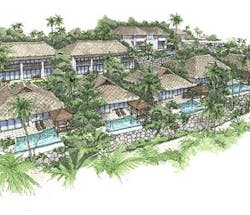Lush architecture and bold designs signify the rich history of India, as exemplified by the re-envisioned Vivanta by Taj, Kovalum. The resort hotel, with its historic architecture and furniture styles, includes bright, spacious rooms, a ballroom, banquet and meeting space. Locally inspired art and artifacts further enhance the ambience of the resort.
Because the existing space was dated, a complete renovation took place in order to make the Vivanta competitive in the market while attracting new clientele, explains Cintia Hayashi, designer/project coordinator with DiLeonardo International. “The design completely uplifted the existing structure to create a fresh aesthetic consisting of a unique fusion of traditional Kerala-style architecture with a contemporary language of design,” she explains. “Additionally, the design allowed for more revenue-generating opportunities within the space for the client.”
Specific to the region, Kerala architecture features “clean-lined, contemporary furniture, pops of bold color and unique, playful details,” says Hayashi. “We played off of the existing architecture, columns and ornate wood carvings to create a modern spin on the old world by playing with Kerala-inspired accents, while everything else was contemporary. The location of the resort is unique in that it really plays up its ‘luscious gardens,’ romantic hidden pathways and beautifully elevated views of its plush surroundings.”
Designing the project from the ground up with a total renovation was a challenging experience. DiLeonardo had to consider where to start from scratch, what could be reused, sustainability options, budgetary concerns and working on a schedule. “While the resort was in absolute need of a complete overhaul, it is difficult to turn your head to some of the amazingly ornate existing details and uses of wood,” says Hayashi. “There were many hidden gems uncovered within the existing structure that inspired the rest of the design. This adds another layer to the design, which is both rewarding and time-consuming.”
Existing conditions within the space also made the rebuild unique. “Low ceilings and many existing beams—especially in the lobby and reception area—required a different design approach in order to open the property and makes guests feel as if they are in a larger space,” she says. “Additionally, there were code concerns that needed to be reworked in order to allow for proper circulation. This required much collaboration with the local architect on our end.”
From room to room within the space, color patterns, fabrics, textiles, woods and furniture styles tie in to India’s culture and history, playing up the existing historic architecture and juxtaposing it with a contemporary design language. This can be seen in the clean lines, geometric abstractions, modern tiles, lacquer finishes and white paint. DiLeonardo referenced existing ornate details and carvings, and played them up with a modern twist to create a distinct fusion of the old world meets new. “Reusing existing materials in a modern way was an important part of the design,” says Hayashi. “This had to be done while paying respect to the local region and culture, which is seen in many of the details and color accents.”
Doing a full renovation allowed DiLeonardo to apply environmental strategies to the project, with a particular emphasis placed on reusing existing and reclaimed materials. The design team worked with local artisans for artwork, artifacts and furniture design. “This not only allows for the local region to be reflected in the design of the resort, but also cuts down on the development’s carbon footprint,” says Hayashi. “We put an emphasis on open-air spaces throughout the resort, especially in the lobby, all-day dining restaurant and majority of the public spaces, to create natural ventilation. We designed a lanai area to wrap around the majority of the lobby and reception area, which created a shaded area, allowing cool air in as cross-ventilation throughout the resort.”
“Branding made a large impact on the project because we worked with a new lifestyle brand recently introduced by a global operator,” Hayashi notes. The designers worked closely with partners and consultants to properly integrate the brand into the design. “This was done on both a large and small scale,” she says. “Oftentimes, the best way to infuse the brand along with the design is done in a subtle yet smart manner. As they say, it’s in the details.”
Creating a distinctive world-class hotel requires close collaboration between the designer and client, and willingness on the part of the design team to listen and fulfill the client’s needs, says Hayashi. “Especially in the case of a renovation, it is imperative to understand the best use of the building and what’s best for the project. This is not always the coolest/hippest/newest/trendiest design, but rather must work from both an aesthetic and functional perspective. The key to designing a world-class hotel in any era is to understand your project from both a business and design perspective.
Additionally, especially in the case of designing a hotel in a beautiful and unique region such as Kerala, the ability and will to integrate the local region and culture into the design makes a huge impact on the spaces and allows guests to experience the sense of place that they crave.”
